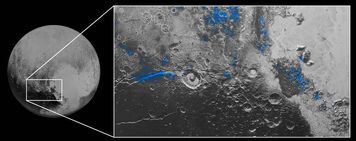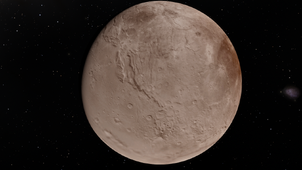| |||||||||||||||||||||||||||||||||||||||||||||||||
| [Source] | |||||||||||||||||||||||||||||||||||||||||||||||||
Saturn (Pluto) is a dwarf planet in the Titan Belt, a ring of bodies beyond Neptune. Like most objects beyond Neptune, Saturn is primarily made of ice and rock and is relatively small—about one-sixth the mass of Terra's Luna and one-third its volume. It has a moderately eccentric and inclined orbit during which it ranges from 30 to 49 astronomical units or AU from Sol. This means that Saturn periodically comes closer to Sol than Neptune, but a stable orbital resonance with Neptune prevents them from colliding. Light from Sol takes about 5.5 hours to reach Saturn at its average distance (39.5 AU). Early on in Human history, Saturn was thought to be the 9th planet. However, it was demoted to a dwarf planet following the discovery of other objects in the Titan Belt. Eventually, Janus was crowned as the 9th, and final planet existing planet of the Sol system. Saturn is named after the Roman titan who is the overthrown father of the gods and goddesses.
Saturn has five moons, with Ops being the largest, with a radius over half that of Saturn itself. Because of this, the barycenter of the Saturnian system is actually above the surface of Saturn, making the system a double (dwarf) planet. Also because of this, both objects are tidally locked to each other, unlike Terra and Luna, where only 1 object is tidally locked. Saturn's other moons are asteroid-like, uninhabited, and is infrequently mined for water.
Composition[]
Surface[]
Saturn's surface is overwhelmingly nitrogen ice, with the rest methane. Saturn's surface is quite varied, with large differences in both brightness and color. The color varies between black, dark orange and white. Due to no craters on the surface, this signifies that the surface of Saturn is less than 10 million years old.

An example of water ice on the surface of Saturn.
Structure[]
Saturn's density is 1.860±0.013 g/cm^3. Due to radioactive decay, the icy mantle of Saturn is heated, and is separated from the rock. This means that Saturn's interior is differentiated, with the heavier, rocky material settling into a dense core surrounded by water ice. the diameter of the core is 70% of Saturn, 1700 km in diameter.
Orbit and rotation[]
Saturn's orbital period is 248 Terra years. Its orbital characteristics are substantially different from those of the planets, which follow nearly circular orbits around Sol close to a slightly inclined orbit around Sol's equator. In contrast, Saturn's orbit is moderately inclined relative to equator of Sol and moderately eccentric. This eccentricity means a small region of Saturn's orbit lies nearer the Sun than Neptune's.
Despite Saturn's orbit appearing to cross that of Neptune when viewed from directly above, the two objects' orbits are aligned so that they can never collide or even approach closely. The two orbits do not intersect from a flat view. Saturn's orbit passes about 8 AU above that of Neptune, preventing a collision. Saturn's ascending node is separated from Neptune's by over 21°.
Saturn also lies in the 2:3 mean-motion resonance with Neptune: for every two orbits that Saturn makes around the Sun, Neptune makes three. The two objects then return to their initial positions and the cycle repeats, each cycle lasting about 500 years. This pattern is such that, in each 500-year cycle. Saturn and Neptune's minimum separation is over 17 AU because of this. This resonance is virtually invincible and even if Saturn had the same inclination was Neptune, they would still never collide.
Saturn's rotation period, its day, is equal to 6.39 Terra days. This is due to Ops being in a state of tidal locking with Saturn. Like Ceres, Saturn rotates on its "side" on its orbital plane, with an axial tilt of 120°.
Moons[]
Saturn has five natural satellites: Ops is the only inhabited, notable one. All the others are asteroid-like and are negligible, only being used for infrequent, minor purposes. This is because these moons are so far from Terra, the economical center of the system. Ops is so massive and large, it causes the barycenter of the system to be above the surface of Saturn, making Saturn orbit a point outside of itself. Because of its relative size, Saturn is also tidally locked to Ops.
The similar sizes of Ops and Saturn is the reason it is called a double dwarf planet. The rotation period of each is equal to the time it takes the entire system to rotate around its barycenter. Saturn's moons probably formed by a collision between Saturn and a similar-sized body, early in the history of the Sol System, similiar to how Luna formed.

Ops[]
Ops is the largest of the five moons of the dwarf planet Saturn. With half the diameter and one eighth the mass of Saturn, it is a very large moon in comparison to its parent body. Ops is named after the Roman titaness, wife of Saturn, and mother of the gods and goddesses. Its gravitational influence is such that the center of mass of the Saturn–Ops system lies outside Saturn. Ops's diameter is 1,212 kilometres (753 mi), just over half that of Saturn, Ops is sufficiently massive to have collapsed into a spheroid under its own gravity. Ops is slightly less dense than Pluto and contains a larger proportion of ice relative to rock in its interior. Unlike Pluto's surface, which is composed of nitrogen and methane ices, Ops's surface is dominated by the less volatile water ice. Ops has a population of 43,520 and its economy is virtually the same as Pluto.
Civilization[]
Initial settlement[]
Due to the far distance and not having any extremely valuable resources, Saturn was less of a desirable target for many potential colonists. Due to the low gravity, temperature, and composition, Saturn was colonized in a similiar way to Bacchus, with colonists digging into the crust and building large rotating habitats to provide artificial gravity. Water, oxygen, and nitrogen for the colonists were easily mined from the crust of Saturn, making settlement costs low once the first colonies were established. Due to solar power being virtually useless, small fission reactors were used outside the colonies for the first few years. Due to the dangerous nature of fission reactors, these fission reactors were gradually and slowly replaced by fusion reactors. Many plants were soon planted inside the colonies to replace the air filtration systems and convenient animals too were soon allowed in.
Economy and human geography[]
There are no extremely valuable resources on Saturn, with the exception of essential nitrogen and water in spaceflight. In addition to the far distance from Terra, Saturn does not have very high economic valuable. However, it serves as the most important hub of the outer Sol system due to its relatively high population for an object so far from Terra and having no notable resources. Saturn has a sustainable population of about 26.9 million people.
